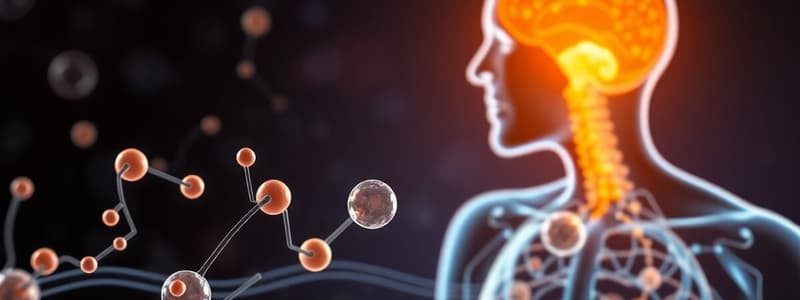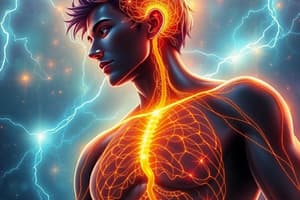Podcast
Questions and Answers
A patient with Cushing's syndrome exhibits insulin-resistant diabetes. How does excessive cortisol contribute to this condition?
A patient with Cushing's syndrome exhibits insulin-resistant diabetes. How does excessive cortisol contribute to this condition?
- By decreasing gluconeogenesis in the liver and increasing glucose utilization.
- By increasing insulin sensitivity in peripheral tissues.
- By downregulating GLUT4 transporters in skeletal muscle and adipose tissue, reducing glucose uptake. (correct)
- By increasing glycogen formation in the liver, leading to hyperglycemia.
During prolonged stress, cortisol influences energy substrate availability. Which of the following metabolic effects aligns with cortisol's role in stress response?
During prolonged stress, cortisol influences energy substrate availability. Which of the following metabolic effects aligns with cortisol's role in stress response?
- Decreased proteolysis to conserve muscle mass.
- Increased lipolysis, providing glycerol for gluconeogenesis. (correct)
- Increased glycogen synthesis in the liver to store glucose.
- Increased glucose uptake in skeletal muscle for immediate energy use.
How does cortisol contribute to maintaining blood pressure under normal physiological conditions?
How does cortisol contribute to maintaining blood pressure under normal physiological conditions?
- By directly stimulating mineralocorticoid receptors (MRs) in the kidneys.
- By antagonizing the effects of aldosterone on renal sodium reabsorption.
- By inhibiting the production of angiotensinogen in the liver.
- By upregulating α1 receptors on arterioles, enhancing vasoconstriction. (correct)
Why doesn't cortisol typically exert a strong mineralocorticoid effect, given its affinity for mineralocorticoid receptors (MR)?
Why doesn't cortisol typically exert a strong mineralocorticoid effect, given its affinity for mineralocorticoid receptors (MR)?
A researcher is investigating the effects of long-term glucocorticoid use on muscle tissue. What would be the expected outcome of excessive cortisol levels on muscle protein metabolism?
A researcher is investigating the effects of long-term glucocorticoid use on muscle tissue. What would be the expected outcome of excessive cortisol levels on muscle protein metabolism?
Which of the following mechanisms directly contributes to the regulation of aldosterone release?
Which of the following mechanisms directly contributes to the regulation of aldosterone release?
A patient presents with elevated blood pressure and hypokalemia. Which of the following scenarios would most directly suggest primary hyperaldosteronism as the underlying cause?
A patient presents with elevated blood pressure and hypokalemia. Which of the following scenarios would most directly suggest primary hyperaldosteronism as the underlying cause?
How does aldosterone affect gene expression after binding to its receptor?
How does aldosterone affect gene expression after binding to its receptor?
Why can licorice consumption lead to symptoms resembling hyperaldosteronism?
Why can licorice consumption lead to symptoms resembling hyperaldosteronism?
A researcher is studying the transport of aldosterone in the bloodstream. Which of the following statements accurately describes how aldosterone is transported?
A researcher is studying the transport of aldosterone in the bloodstream. Which of the following statements accurately describes how aldosterone is transported?
Why is corticosteroid 11β-dehydrogenase isozyme 2 important in mineralocorticoid receptor (MR) function?
Why is corticosteroid 11β-dehydrogenase isozyme 2 important in mineralocorticoid receptor (MR) function?
How does aldosterone increase sodium reabsorption in the kidney?
How does aldosterone increase sodium reabsorption in the kidney?
What is the primary effect of aldosterone on potassium levels in the body?
What is the primary effect of aldosterone on potassium levels in the body?
Which of the following describes how aldosterone affects acid-base balance in the body?
Which of the following describes how aldosterone affects acid-base balance in the body?
A patient presents with hypertension and hypokalemia. Which of the following conditions is most likely contributing to these findings?
A patient presents with hypertension and hypokalemia. Which of the following conditions is most likely contributing to these findings?
Besides the kidney, where else does aldosterone stimulate sodium reabsorption?
Besides the kidney, where else does aldosterone stimulate sodium reabsorption?
What effect does increased serum potassium concentration have on aldosterone secretion?
What effect does increased serum potassium concentration have on aldosterone secretion?
How does Angiotensin II affect aldosterone secretion?
How does Angiotensin II affect aldosterone secretion?
How does cortisol impact the inflammatory response and immunity?
How does cortisol impact the inflammatory response and immunity?
What are the effects of chronically elevated cortisol levels on bone health?
What are the effects of chronically elevated cortisol levels on bone health?
How does cortisol influence memory and cognition?
How does cortisol influence memory and cognition?
Which of the following acronyms correctly summarizes some of the major effects of cortisol?
Which of the following acronyms correctly summarizes some of the major effects of cortisol?
What initiates the secretion of cortisol in response to stress?
What initiates the secretion of cortisol in response to stress?
How do glucocorticoids administered to mothers in premature labor assist fetal development?
How do glucocorticoids administered to mothers in premature labor assist fetal development?
A patient presents with a history of chronic skin rashes and an inflammatory kidney disease. Cortisol is prescribed as a treatment. What is the intended mechanism of action of cortisol in this scenario?
A patient presents with a history of chronic skin rashes and an inflammatory kidney disease. Cortisol is prescribed as a treatment. What is the intended mechanism of action of cortisol in this scenario?
How would a drug that inhibits the function of the limbic system affect cortisol secretion in response to an emotional stressor?
How would a drug that inhibits the function of the limbic system affect cortisol secretion in response to an emotional stressor?
A patient with liver cirrhosis exhibits decreased production of corticosteroid-binding globulin (CBG). How would this condition most likely affect the patient's cortisol activity?
A patient with liver cirrhosis exhibits decreased production of corticosteroid-binding globulin (CBG). How would this condition most likely affect the patient's cortisol activity?
During emergency surgery, why might a patient who has been on long-term corticosteroid therapy, such as prednisone, need additional corticosteroids?
During emergency surgery, why might a patient who has been on long-term corticosteroid therapy, such as prednisone, need additional corticosteroids?
Which of the following is the correct sequence of steps in cortisol production?
Which of the following is the correct sequence of steps in cortisol production?
If a patient has a tumor that causes excessive production of ACTH, which of the following would be the expected outcome regarding cortisol levels and adrenal gland morphology?
If a patient has a tumor that causes excessive production of ACTH, which of the following would be the expected outcome regarding cortisol levels and adrenal gland morphology?
How does cortisol affect glucose metabolism in the body?
How does cortisol affect glucose metabolism in the body?
A researcher is studying the effects of a new drug on cortisol activity. They observe that the drug binds to glucocorticoid receptors (GRs) but does not activate them. What is the likely effect of this drug on cortisol's actions?
A researcher is studying the effects of a new drug on cortisol activity. They observe that the drug binds to glucocorticoid receptors (GRs) but does not activate them. What is the likely effect of this drug on cortisol's actions?
What is the primary reason that only free cortisol, unbound to CBG, can activate intracellular receptors?
What is the primary reason that only free cortisol, unbound to CBG, can activate intracellular receptors?
How does pregnancy typically affect total cortisol levels, CBG levels, and free cortisol levels in a woman's body?
How does pregnancy typically affect total cortisol levels, CBG levels, and free cortisol levels in a woman's body?
Flashcards
Cortisol
Cortisol
A hormone that affects glucose metabolism, immune function, cognition, and bone formation.
Cortisol's effect on glucose
Cortisol's effect on glucose
Increases serum glucose by gluconeogenesis and decreases glycogen formation in the liver.
Cortisol's effects on fats/proteins
Cortisol's effects on fats/proteins
Increased breakdown of fats (lipolysis) and proteins (proteolysis) for energy during stress.
Cushing syndrome and Diabetes
Cushing syndrome and Diabetes
Signup and view all the flashcards
Cortisol and Blood Pressure
Cortisol and Blood Pressure
Signup and view all the flashcards
Adrenocorticotropic Hormone (ACTH)
Adrenocorticotropic Hormone (ACTH)
Signup and view all the flashcards
Cortisol Synthesis Steps
Cortisol Synthesis Steps
Signup and view all the flashcards
Cortisol Action on Tissues
Cortisol Action on Tissues
Signup and view all the flashcards
Corticosteroid-Binding Globulin (CBG)
Corticosteroid-Binding Globulin (CBG)
Signup and view all the flashcards
Free Cortisol
Free Cortisol
Signup and view all the flashcards
CBG and Total Cortisol During Pregnancy
CBG and Total Cortisol During Pregnancy
Signup and view all the flashcards
Importance of Cortisol
Importance of Cortisol
Signup and view all the flashcards
What is Aldosterone?
What is Aldosterone?
Signup and view all the flashcards
What is StAR?
What is StAR?
Signup and view all the flashcards
How is Aldosterone transported?
How is Aldosterone transported?
Signup and view all the flashcards
What is Mineralocorticoid Receptor (MR)?
What is Mineralocorticoid Receptor (MR)?
Signup and view all the flashcards
What does Aldosterone do?
What does Aldosterone do?
Signup and view all the flashcards
Cortisol's Effect on Immunity
Cortisol's Effect on Immunity
Signup and view all the flashcards
Cortisol as Anti-Inflammatory
Cortisol as Anti-Inflammatory
Signup and view all the flashcards
Cortisol's Effect on Bones
Cortisol's Effect on Bones
Signup and view all the flashcards
Cortisol and Fetal Lung Development
Cortisol and Fetal Lung Development
Signup and view all the flashcards
Cortisol's Effect on Memory
Cortisol's Effect on Memory
Signup and view all the flashcards
Cortisol's BIG FIB (Increases)
Cortisol's BIG FIB (Increases)
Signup and view all the flashcards
Cortisol's BIG FIB (Decreases)
Cortisol's BIG FIB (Decreases)
Signup and view all the flashcards
Mineralocorticoids Definition
Mineralocorticoids Definition
Signup and view all the flashcards
Mineralocorticoid Receptor (MR)
Mineralocorticoid Receptor (MR)
Signup and view all the flashcards
Corticosteroid 11β-dehydrogenase isozyme 2
Corticosteroid 11β-dehydrogenase isozyme 2
Signup and view all the flashcards
Kidney: Aldosterone Actions
Kidney: Aldosterone Actions
Signup and view all the flashcards
Aldosterone: H+ secretion Stimulation
Aldosterone: H+ secretion Stimulation
Signup and view all the flashcards
Primary Hyperaldosteronism
Primary Hyperaldosteronism
Signup and view all the flashcards
Aldosterone's Non-Kidney Actions
Aldosterone's Non-Kidney Actions
Signup and view all the flashcards
Angiotensin II and Aldosterone
Angiotensin II and Aldosterone
Signup and view all the flashcards
Potassium's Effect on Aldosterone
Potassium's Effect on Aldosterone
Signup and view all the flashcards
Study Notes
- The lecture discusses the functions of adrenocortical hormones, specifically cortisol and aldosterone.
- Dr. Sovan Bagchi is the Professor of Physiology at Gulf Medical University.
Learning objectives
- Define cortisol and know where it is produced.
- Explain the process of cortisol synthesis.
- Identify the cellular binding and major physiological actions of cortisol.
- Describe the regulation of cortisol release by the adrenal gland.
- Define mineralocorticoids and specify their site of production.
- Explain aldosterone synthesis and transport.
- Identify the cellular binding and major physiological actions of aldosterone.
- Describe how the adrenal glands regulate the release of aldosterone.
Case Study
- A college roommate, AS, takes corticosteroid medication (prednisone) to prevent rejection of her transplanted kidney,
- Then needed more corticosteroids for emergency surgery, raising the question of why extra steroids were needed during stress.
What Is Cortisol?
- A steroid hormone produced in the adrenal gland, specifically in the zona fasciculata.
- Cortisol is a glucocorticoid that regulates glucose metabolism and is also known as a corticosteroid.
How Is Cortisol Synthesized?
- Cortisol production depends on adrenocorticotropic hormone (ACTH).
- Cortisol production steps:
- Cholesterol synthesis using desmolase, STAR and ACTH.
- Mitochondrial conversion.
- Smooth endoplasmic reticulum.
How Does Cortisol Act on Tissues?
- Impacts many bodily functions because most cells possess glucocorticoid receptors (GRs) that bind to cortisol.
Transport and Receptor Binding
- About 90% of is bound to corticosteroid-binding globulin (CBG), also known as transcortin.
- Synthesized in the liver, prolongs cortisol's half-life.
- Only about 3% travels freely in the plasma.
- Only unbound cortisol can enter cells and activate receptors.
- Total cortisol and CBG levels commonly elevate during pregnancy but free cortisol remains normal and the patient won't have high cortisol symptoms.
Diverse Effects
- A hormone crucial for life, and deficiencies have fatal consequences.
- Affects: glucose, overall metabolism, immune system, cognition, bone formation, and fetal development.
Metabolism
- Increases energy-generating substrates like glucose, glycerol, and amino acids for use during stress.
- Elevates serum glucose.
- Gluconeogenesis, lowers glycogen formation (in the liver).
- Reduces glucose uptake by decreasing GLUT4 transporters.
- Leads to insulin resistance.
- Decreases insulin and increases glucagon secretion.
- Affects serum glucose concentration
- Lipolysis generates glycerol for energy during stress
- Increases proteolysis into amino acids for energy or glucose conversion.
- Inhibits protein synthesis and lowers peripheral amino acid uptake in muscles.
- High cortisol levels (Cushing syndrome) causes insulin-resistant diabetes.
Maintaining Blood Pressure
- Supports normal pressure by up-regulating vasoconstricting a₁ receptors on arterioles.
- High concentrations trigger mineralocorticoid receptors (MRs), increasing sodium reabsorption, blood volume, and blood pressure.
- The MR shares the affinity.
- The mineralocorticoid effect is normally blocked by corticosteroid 11β-dehydrogenase, meaning cortisol would dominate MR signaling
Immunity and Wound Healing
- Impairs wound healing and suppresses the immune system
- Acts as an anti-inflammatory molecule that slows inflammations and immune reactions.
- Ultimately causes immune suppression and poor wound healing
- As a drug, it is used to limit inflammation in chronic inflammatory conditions like skin rashes.
Additional Cortisol Functions
- Bone formation decreases.
- Fetal lung development modulation.
- Surfactant production
- Cognition and memory stimulation.
- Terminal maturation and axon remodeling.
- Osteoblast activity is reduced by it.
- For premature labor, glucocorticoids are given to promote the baby’s lung development.
- Risk of osteoporosis is higher for people on chronic glucocorticoid drugs.
Increases Memory and Cognition
- Stimulates the formation of memories linked to both strong emotions, whether good or bad.
- Enhances alertness and cognition
- Through its effects on the hippocampus, amygdala, and frontal lobes.
Cortisol effects (BIG FIB acronym)
- Increases Blood pressure, Insulin resistance, Gluconeogenesis, lipolysis, and proteolysis.
- Decreases Fibroblast activity, Inflammation and immune response, and Bone production.
How Is Cortisol Secretion Regulated?
- This process involves stress, the hypothalamus, CRH, the anterior pituitary, ACTH, and the adrenal gland.
- Cortisol levels are highest upon waking up and decline during sleep.
Relation to stress
Stress -> paraventricular nucleus of the hypothalamus -> limbic system -> hypothalamus (CRH) -> ACTH (anterior pituitary) -> Cortisol
Mineralocorticoids
- Objectives include defining mineralocorticoids, their production site, aldosterone synthesis, transport, cellular binding, effects, and how adrenal glands regulate aldosterone release.
- Aldosterone is critical for maintaining blood volume.
- Responsible for the sodium and water reabsorption (secondary effect) in the kidney.
- Regulates potassium to excrete excess potassium.
Site of Production
- Steroid hormones created in the adrenal gland inside the zona glomerulosa.
How Is Aldosterone Synthesized?
- Cholesterol -> Pregnenolone using Demolase, ACTH, and StAR -> Progesterone -> Corticosterone -> Aldosterone using Angiotensin II in the smooth endoplasmic reticulum.
- Steroidogenic acute regulatory protein (STAR) is a rate-limiting enzyme.
Transport
- 50% of aldosterone binds to serum albumin
- 17% binds to corticosteroid-binding globulin (CBG)/transcortin.
- 30% circulates freely in the blood
Receptor Binding
- Binds to the mineralocorticoid receptor (MR; intracellular)
- MR equal affinity for mineralocorticoids and for cortisol
- The aldosterone-MR complex then enters the nucleus, binds to hormone response elements and modulating multiple genes expressions (repressing or enhancing their transcription)
What Does Aldosterone Do?
- Acts as a ligand-dependent transcription factor (TF).
- Alters cell signaling which regulated water and ion transport
- As a protection mechanism, corticosteroid 11ẞ-dehydrogenase isozyme 2 metabolizes cortisol to stop it binding to MR
- High levels of circulating cortisol does not dominate MR signaling
Actions in the Kidney
- Facilitates sodium reabsorption and potassium excretion.
- Increasing the sodium channels on the lumen side of the cell.
- Na+/K+-ATPase pump activity on the basolateral side of the cell
- Stimulates H+-ATPase on a-intercalated cells.
- This increases urinary potassium excretion.
Clinical Correlation
- Primary hyperaldosteronism can cause hypertension by continuously secreting aldosterone.
Actions Outside the Kidney
- Stimulates sodium reabsorption through its actions on receptors in the colon, salivary, and sweat glands,
How Is Aldosterone Secretion Regulated?
- Via Angiotensin II
- Activation of the renin-angiotensin-aldosterone system (RAAS) occurs when there is a drop in blood pressure or blood volume.
- RAAS activation generates angiotensin II.
- Via increased serum concentration
- When serum potassium rises.
- Increases renal potassium excretion.
- Circulating Adrenocorticotropic Hormone
- The presence of ACTH is required for aldosterone synthesis
Test your Knowledge
- Aldosterone increases sodium reabsorption at the collecting ducts?
- Stimulates insertion of Na+/K+-ATPase in principal cells
- Most potent stimulant of CRH release?
- Stress
Studying That Suits You
Use AI to generate personalized quizzes and flashcards to suit your learning preferences.
Related Documents
Description
Explore the roles of cortisol and aldosterone in endocrine function. Questions cover cortisol's impact on insulin resistance, energy metabolism, and blood pressure. Also, explore aldosterone's regulation and its effects on blood pressure and potassium levels.





